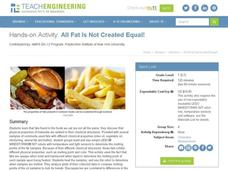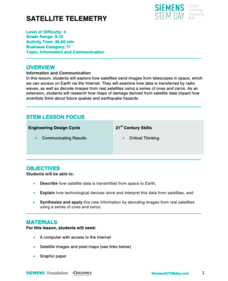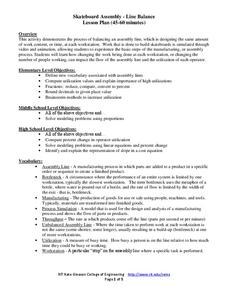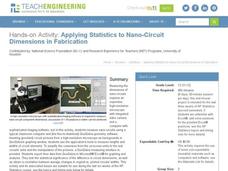Perkins School for the Blind
Identifying and Using Tools
How can you teach a person about technology and engineering if he has never been exposed to the tools and devices used to create and construct? Learners with visual impairments examine a number of common tools, such as hammers, wrenches,...
Institute of Electrical and Electronics Engineers
Water Fountain
Thorough instructions are given to guide you through making a demonstration hydraulic pump from two plastic soda bottles. After using the resource to teach your class about Pascal's and Bernoulli's principles, turn them loose in groups...
Teach Engineering
All Fats Are Not Created Equal
Apply robotics to connect physical properties to chemical properties. Future engineers use robots to determine the melting points of various fats and oils. The robots can do this by measuring the translucency of the fats as they heat up.
NPR
Test and Evaluate the Prototype
Time to test the prototype. Groups test their prototypes to the plastics problem under consideration. The results of the tests and peer feedback offer a means to refine the prototype.
NPR
Iterate to Improve the Prototype
Strive for perfection. Based on peer feedback, groups identify ways to improve their prototypes of the solution to the plastics problem. Members must come up with at least two ideas for improvements. This is the eighth instructional...
NPR
Investigate the Plastic Problem
Plastics are forever. The second lesson in a 10-part unit has pupils research the effects of plastics on the environment. They present their findings by creating an infographic.
NPR
Prototype the Solution
It's always nice to see what the solution looks like. Groups build a prototype of their solution to the plastics problem in the sixth installment of a 10-part unit. The prototypes can be either a visual prototype or a working prototype.
NPR
Brainstorm and Evaluate Solutions
May the best idea win. In groups, scholars brainstorm solutions to the problem statement developed in the previous lesson. The best idea moves forward to the prototype stage.
Discovery Education
Satellite Telemetry
Satellites require rockets to launch, but it doesn't take a rocket scientist to understand them. Future engineers learn about how satellites send data to Earth and how to interpret satellite images. They see how radio waves play a role...
Curated OER
Paper Suspension Bridges: You Want Me To Go Up There?
A few class periods will be required to complete this physics investigation with your high schoolers. There is an unavailable video written into the lesson plan, but there is plenty of material here to bridge the gap. Two terrific...
Curated OER
Erosion... Can You Fight It?
Learners study erosion and its effects on shorelines. For this erosion lesson, students work in an engineering team to design a seawall and submit a cost bid to their teacher. Learners must determine the energy of a wave and design a...
Lawrence Hall of Science
HowtoSmile
Access countless activities to use in STEM curriculum. This app is a collection of science, technology, engineering, math, and even art ideas are cataloged by topic and easily accessed from one spot.
National Nanotechnology Infrastructure Network
Is Measuring an Art or a Science?
Not only do future engineers learn the difference between accuracy and precision, they also get some hands-on experience using different measuring tools.
Aurora Trust
Journey Under the Sea
Discover the interesting world of maritime archaeology and explorations under the sea with this nice set of worksheets, which cover such topics as search tools and techniques of underwater archaeology, carbon dating, vessel types, and...
Mrs. Burgess
End of the Year Geometry Projects
Geometry students will be ecstatic about these engaging and enlightening end-of-the-year projects! Types of project ideas include interviewing a geometer, an ABCs of geometry poster, an engineering lab report, and origami work.
Technical Sketching
Introduction — Surfaces and Edges
How different can 3-D and 2-D really be? An engineering resource provides an explanation about the importance of two-dimensional technical drawings. Several samples show how to create multi-view drawings from pictorials and vice-versa....
Discovery Education
Future Fleet
Turn your pupils into engineers who are able to use scientific principals to design a ship. This long-term project expects pupils to understand concepts of density, buoyancy, displacement, and metacenter, and apply them to constructing a...
Rochester Institute of Technology
Skateboard Assembly - Line Balance
Utilize the instructional activity on utilization. The second installment of a nine-part technology/engineering series teaches scholars about the flow of a balanced assembly line and the definition of utilization. Videos, activities, and...
Rochester Institute of Technology
Hazmat Disposal
What a waste! The last installment of a nine-part technology/engineering series teaches learners about medical waste disposal systems. Conducting a simulation allows individuals to understand how monetary considerations constrain waste...
Teach Engineering
Applying Statistics to Nano-Circuit Dimensions in Fabrication
Do flexible circuits change dimensions during fabrication? Groups use GeoGebra software to measure the length of pictures of flexible nano-circuits. To determine if the circuits change dimensions, future engineers use Microsoft Excel to...
Florida International University
Designing an Autonomous Underwater Vehicle (AUV): Concepts in Lift, Drag, Thrust, Energy, Power, Mass, and Buoyancy
Engineer an autonomous underwater vehicle (AUV) to study concepts of physics. Using household materials, collaborative groups design and build an AUV and then test Newton's Laws of Motion as they apply them in underwater environments...
DiscoverE
Creepy Putty
Mold your learners into materials engineers. Using glue, Borax, and water, scholars create a viscoelastic material. But your class might know it by another name—Silly Putty.
Agriculture in the Classroom
Design 'Y'er Genes
How do changes in DNA affect an organism? Scholars explore chromosomes, genes, DNA, and mutations by modeling the DNA of a strawberry. They build a DNA model, then manipulate it to show how changing the genes transforms the strawberry...
American Chemical Society
What is Wind?
Engage creative minds with an exciting activity about the power of wind. Investigators participate in class discussions while viewing images and animations of air and wind. Scholars test the relationship between wind speed and an...
Other popular searches
- Genetic Engineering
- Engineering and Technology
- Nuclear Engineering
- Engineering Design Process
- Civil Engineering
- Mechanical Engineering
- Electrical Engineering
- Environmental Engineering
- Engineering Graphics
- Chemical Engineering
- Biomedical Engineering
- Cloning Genetic Engineering

























